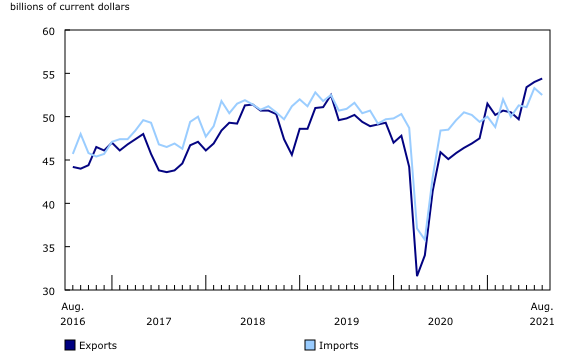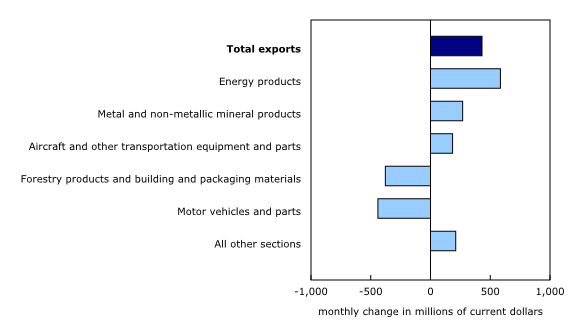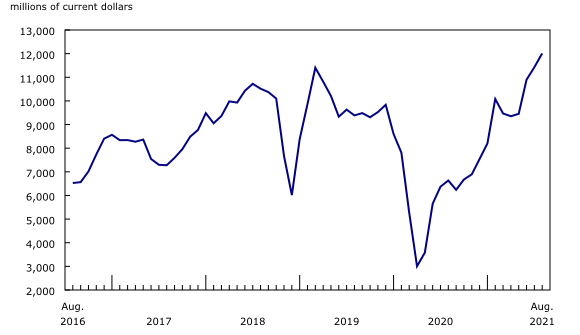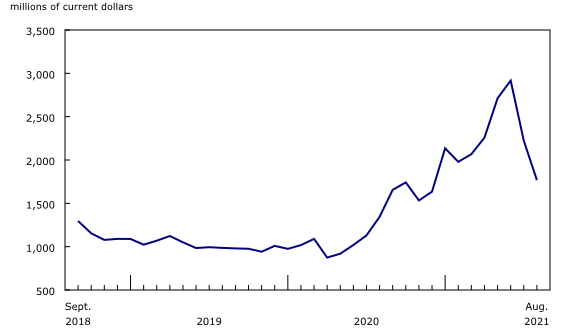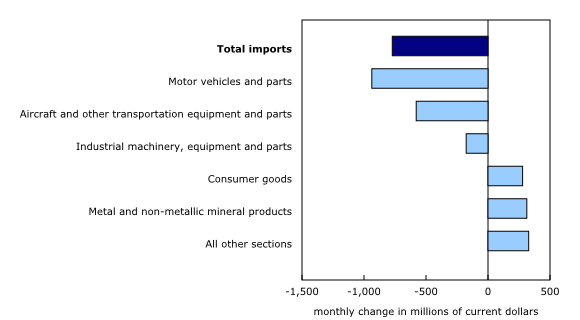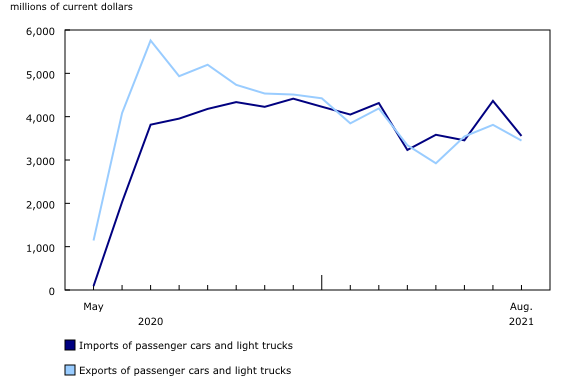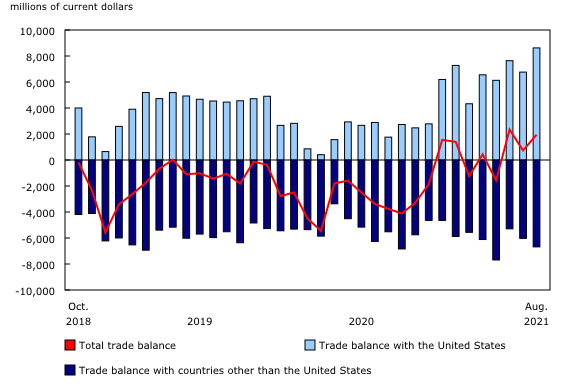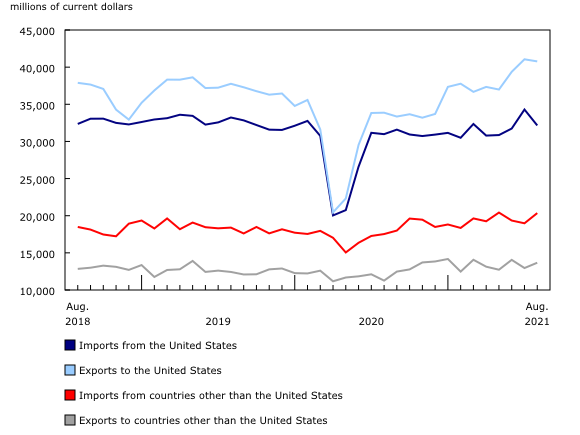Canadian international merchandise trade, August 2021
Archived Content
Information identified as archived is provided for reference, research or recordkeeping purposes. It is not subject to the Government of Canada Web Standards and has not been altered or updated since it was archived. Please "contact us" to request a format other than those available.
Released: 2021-10-05
Canada's merchandise exports increased 0.8% in August, while imports decreased 1.4%. As a result, Canada's merchandise trade balance with the world remained in a surplus position, widening from $736 million in July to $1.9 billion in August.
Consult the "International trade monthly interactive dashboard" to explore the most recent results of Canada's international trade in an interactive format.
The Canadian International Merchandise Trade Web Application is here
Today, Statistics Canada launches the Canadian International Merchandise Trade Web Application, which will replace the existing CIMT online database. Discover this modern tool that will provide Statistics Canada's trade data users with a number of enhancements, including access to the full 8-digit (exports) and 10-digit (imports) Harmonized System product categories, as well as insights on CIMT in a more user-friendly, efficient and visually appealing manner. Watch this video to learn more about the added data and features.
Exports of energy products and metal products rise
Total exports increased 0.8% in August to $54.4 billion, a third consecutive monthly gain. Exports were up in 6 of 11 product sections with energy products rising the most. Non-energy exports edged down 0.4%. In real (or volume) terms, total exports rose 2.3%.
Exports of energy products increased 5.1% in August to $12.0 billion, the highest level since a record $12.8 billion was posted in March 2014. Exports of crude oil (+2.1%) were up the most in August—a fourth consecutive monthly gain—on the strength of increased volumes. Coal exports (+42.9%) also contributed to the monthly increase in exports of energy products, in part due to the combined effect of higher prices and higher exported quantities to China and South Korea. Finally, exports of natural gas rose 13.6% in August, mostly due to higher prices, which have risen each month since April.
Exports of metal and non-metallic mineral products rose 4.0% in August to a record $6.9 billion. Higher export values of copper (+72.9%), iron and steel (+6.2%) and aluminum (+5.8%) products were responsible for more than three-quarters of that gain. Although prices have increased significantly since the onset of the pandemic, in part due to rising global demand, higher export volumes were behind the increase for the product section in August.
Following an increase of 6.1% in July, exports of motor vehicles and parts decreased 7.3%, partially offsetting the overall gain in exports in August. Parts supply issues have forced Canadian motor vehicle manufacturers to limit production in most of the first nine months of 2021. The month of August, which is usually characterized by an increase in production following the seasonal shutdowns of July, was also affected by these production cuts, leading to a monthly seasonally adjusted decrease of $440 million, a decline that more than offset the gain observed in July.
Also down in August were exports of forestry products and building and packaging materials (-7.9%). This was the result of lower exports of lumber and other sawmill products (-20.5%), which decreased for a second consecutive month due to lower prices. Despite the two straight monthly declines, export values for lumber and other sawmill products were double the value observed in April 2020, the month before the recent rise in lumber prices began.
Decline in imports of motor vehicles and parts in August partially offsets the gains in July
Following a 4.3% increase and a record high in July, total imports were down 1.4% to $52.5 billion in August, despite gains in a majority of product sections. In real (or volume) terms, total imports decreased 3.2% in August.
Imports of motor vehicles and parts (-11.1%) accounted for most of the monthly change in total imports in August, as was also the case in July. The situation with imports of motor vehicles is very similar to the one observed with exports. Global production of cars and trucks has been impacted by supply issues, significantly affecting Canadian imports since the beginning of 2021. The decrease in imports of motor vehicles and parts in August erased almost two-thirds of the gain observed in July.
Imports of aircraft and other transportation equipment and parts (-28.8%) also contributed to the import decline in August, mainly on lower imports of aircraft, which decreased 80.7% to $82 million. Following two months of high levels in June and July that saw 11 new commercial airliners imported, none were imported in August. Imports of parts of railway rolling stock and of other transportation equipment (-46.3%) were also down in August, mostly because of lower imports of parts from Belgium.
Large decline in imports from the United States
Imports from the United States fell 6.2% in August to $32.2 billion, the largest decline since the historic drops in the first half of 2020. Exports to the United States decreased 0.7% in August to $40.8 billion. As a result, Canada's trade surplus with the United States widened from $6.8 billion in July to $8.6 billion in August, the largest monthly trade surplus with the United States in 13 years.
When the average exchange rates of July and August are compared, the Canadian dollar lost 0.5 US cents relative to the American dollar.
Increase in trade activity with countries other than the United States
Imports from countries other than the United States increased 7.2% in August. Imports from China, Mexico and South Korea all posted large increases, with gains in imports across a number of product categories. Exports to countries other than the United States were up 5.5% in August. Exports to Hong Kong (gold), Germany (iron ore), South Korea (coal) and China (coal) posted notable increases. Canada's trade deficit with countries other than the United States widened from $6.0 billion in July to $6.7 billion in August.
Revisions to July merchandise export and import data
Imports in July, originally reported at $53.0 billion in the previous release, were revised to $53.3 billion in the release for the current reference month. Exports in July, originally reported at $53.7 billion in the previous release, were revised to $54.0 billion in the current month's release.
Monthly trade in services
In August, monthly service exports were up 1.3% to $9.8 billion. Service imports increased 3.7% to $10.1 billion.
When international trade in goods and international trade in services were combined, exports rose 0.9% to $64.2 billion in August, while imports decreased 0.6% to $62.6 billion. As a result, Canada's trade surplus with the world for goods and services widened from $617 million in July to $1.6 billion in August.
Note to readers
Merchandise trade is one component of Canada's international balance of payments (BOP), which also includes trade in services, investment income, current transfers, and capital and financial flows.
International trade data by commodity are available on both a BOP and a customs basis. International trade data by country are available on a customs basis for all countries and on a BOP basis for Canada's 27 principal trading partners (PTPs). The list of PTPs is based on their annual share of total merchandise trade—imports and exports—with Canada in 2012. BOP data are derived from customs data by adjusting for factors such as valuation, coverage, timing and residency. These adjustments are made to conform to the concepts and definitions of the Canadian System of National Accounts.
For a conceptual analysis of BOP-based data versus customs-based data, see "Balance of Payments trade in goods at Statistics Canada: Expanding geographic detail to 27 principal trading partners."
For more information on these and other macroeconomic concepts, see the Methodological Guide: Canadian System of Macroeconomic Accounts (13-607-X) and the User Guide: Canadian System of Macroeconomic Accounts (13-606-G).
The data in this release are on a BOP basis and are seasonally adjusted. Unless otherwise stated, values are expressed in nominal terms, or current dollars. References to prices are based on aggregate Paasche (current-weighted) price indexes (2012=100). Movements within aggregate Paasche prices can be influenced by changes in the share of values traded for specific goods, with sudden shifts in trading patterns—as observed currently with the COVID-19 pandemic—sometimes resulting in large movements in Paasche price indexes. Volumes, or constant dollars, are calculated using the Laspeyres formula (2012=100), unless otherwise stated.
For information on seasonal adjustment, see Seasonally adjusted data – Frequently asked questions.
Revisions
In general, merchandise trade data are revised on an ongoing basis for each month of the current year. Current-year revisions are reflected in both the customs-based and the BOP-based data.
The previous year's customs-based data are revised with the release of data for the January and February reference months, and thereafter on a quarterly basis. The previous two years of customs-based data are revised annually, and revisions are released in February with the December reference month.
The previous year's BOP-based data are revised with the release of data for the January, February, March and April reference months. To remain consistent with the Canadian System of Macroeconomic Accounts, revisions to BOP-based data for previous years are released annually in December with the October reference month.
Factors influencing revisions include the late receipt of import and export documentation, incorrect information on customs forms, the replacement of estimates produced for the energy section with actual figures, changes in merchandise classification based on more current information, and changes to seasonal adjustment factors.
For information on data revisions for exports of energy products, see Methodology for Exports of Energy Products within the International Merchandise Trade Program.
Revised data are available in the appropriate tables.
Real-time data table
The real-time data table 12-10-0120-01 will be updated on October 18, 2021.
Next release
Data on Canadian international merchandise trade for September will be released on November 4, 2021.
Products
The product "International trade monthly interactive dashboard" (71-607-X) is now available. This new interactive dashboard is a comprehensive analytical tool that presents monthly changes in Canada's international merchandise trade data on a balance-of-payments basis, fully supporting the information presented every month in the Daily release.
The product "The International Trade Explorer" (71-607-X) is now available online.
Customs-based data are now available in the Canadian International Merchandise Trade Database (65F0013X).
The updated "Canada and the World Statistics Hub" (13-609-X) is now available online. This product illustrates the nature and extent of Canada's economic and financial relationship with the world using interactive graphs and tables. It provides easy access to information on trade, investment, employment and travel between Canada and a number of countries, including the United States, the United Kingdom, Mexico, China, Japan, Belgium, Italy, the Netherlands and Spain.
Contact information
For more information, contact us (toll-free 1-800-263-1136; 514-283-8300; STATCAN.infostats-infostats.STATCAN@canada.ca).
To enquire about the concepts, methods or data quality of this release, contact Benoît Carrière (613-951-4636; STATCAN.mediahotline-ligneinfomedias.STATCAN@canada.ca), International Accounts and Trade Division.
- Date modified:




